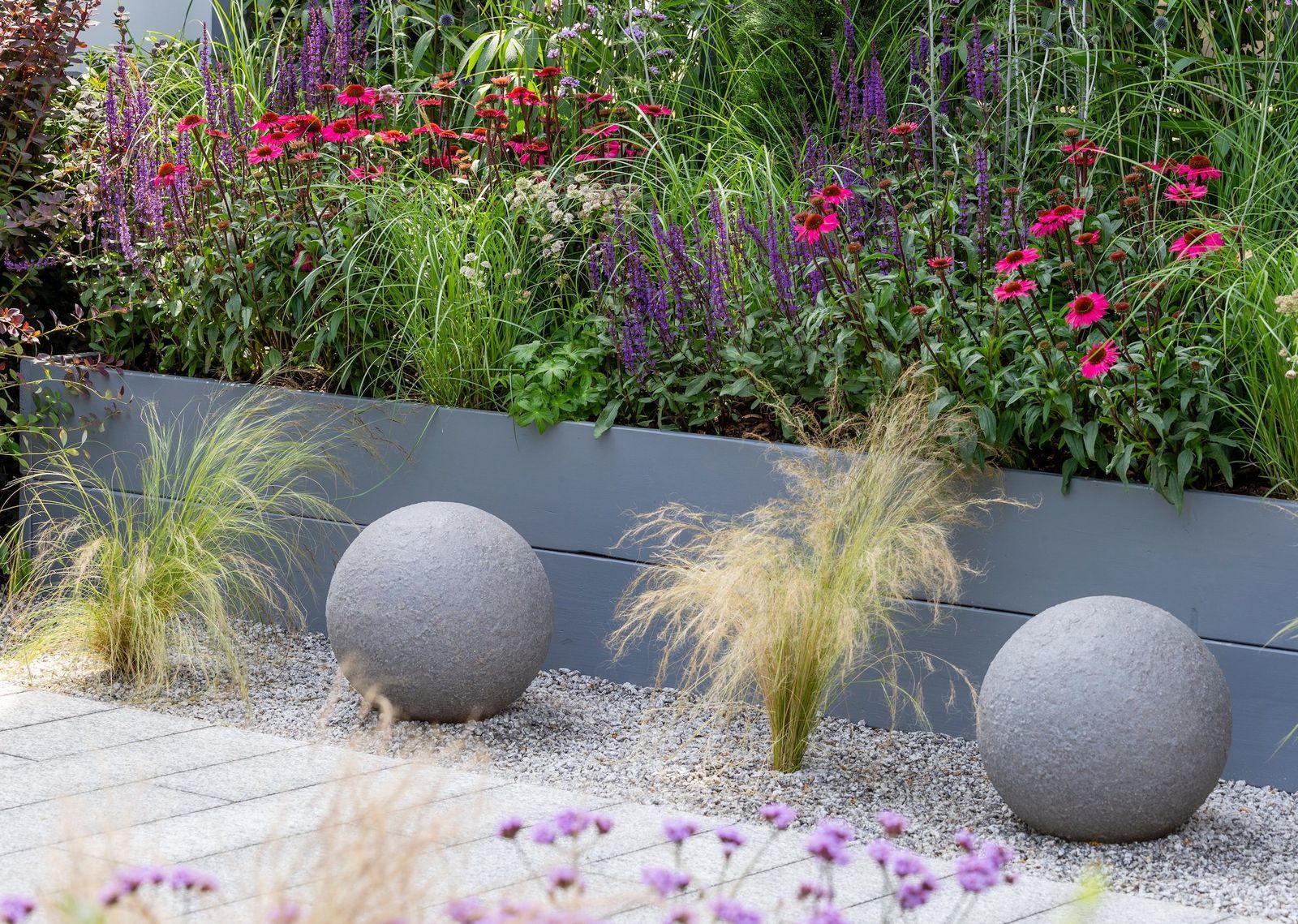
16 garden design ideas to make the best of your outdoor space
2. Plan your planting
The best garden designs start with structural plants infilled with pretty, flowering plants. So use evergreen shrubs at the end of each border and as punctuation along the way. Include small shrubs such as box balls, or large evergreens, for example mahonia, for bigger areas.
Once you have this frame, fill the gaps with pretty flowering plants. Try to stick to just five or six different types and arrange them in repeated patterns for a coordinated and harmonious effect. A metre or more in depth is a perfect size for a border, giving you enough space to put smaller plants at the front with taller ones behind.
Remember, narrow, low-planted beds can define seating or dining areas, as can lines of planted-up troughs – choose evergreen scented plants, such as lavender or Mexican orange blossom. Containers offer the most flexibility though, allowing you to move them around however suits. 'Creeping rosemary is a great plant for edging in containers, as it trails rather than growing upright, is evergreen and covered in blue flowers in spring,' says Tony Woods, managing director of garden design company Garden Club London.
If you don't have room for metre-deep beds, you could place climbers at the back of the border so you can still get height in the planting. In terms of climbing plants, opt for an evergreen like clematis, which provides a beautiful and colourful display.
Tony Woods recommends star jasmine for seating areas: 'It’s very well-behaved, produces masses of white, waxy, scented flowers throughout the summer and reacts well to being cut back, so is ideal for positioning behind a seating area where you don't want plants hanging over and can enjoy the scent.'
When you're choosing flowering plants, try to make some of them 'out of season' performers so you have some year-round colour, or put in spring and early summer bulbs to get the garden off to a great start.
Concerned about the environmental impact of your garden? If you're looking for ways to make it more sustainable, The Samphire Garden by Sue Townsend demonstrates how you can create a garden that benefits the planet and is still bursting with texture and visual interest.
Set amongst paving of locally reclaimed York Stone, the coastal garden in Suffolk uses a rich palette of drought-tolerant planting, including native seaside plants, grasses and Mediterranean shrubs surrounded by a stone mulch in different sizes. Plants include verbena bonariensis, eryngiums, euphorbias, lavender, achillea, ballota, miscanthus nepalensis, pennisetum, verbena and thymus. Ensure you use permeable surfaces to allow water to be released naturally into the ground.
The best garden designs start with structural plants infilled with pretty, flowering plants. So use evergreen shrubs at the end of each border and as punctuation along the way. Include small shrubs such as box balls, or large evergreens, for example mahonia, for bigger areas.
Once you have this frame, fill the gaps with pretty flowering plants. Try to stick to just five or six different types and arrange them in repeated patterns for a coordinated and harmonious effect. A metre or more in depth is a perfect size for a border, giving you enough space to put smaller plants at the front with taller ones behind.
Remember, narrow, low-planted beds can define seating or dining areas, as can lines of planted-up troughs – choose evergreen scented plants, such as lavender or Mexican orange blossom. Containers offer the most flexibility though, allowing you to move them around however suits. 'Creeping rosemary is a great plant for edging in containers, as it trails rather than growing upright, is evergreen and covered in blue flowers in spring,' says Tony Woods, managing director of garden design company Garden Club London.
If you don't have room for metre-deep beds, you could place climbers at the back of the border so you can still get height in the planting. In terms of climbing plants, opt for an evergreen like clematis, which provides a beautiful and colourful display.
Tony Woods recommends star jasmine for seating areas: 'It’s very well-behaved, produces masses of white, waxy, scented flowers throughout the summer and reacts well to being cut back, so is ideal for positioning behind a seating area where you don't want plants hanging over and can enjoy the scent.'
When you're choosing flowering plants, try to make some of them 'out of season' performers so you have some year-round colour, or put in spring and early summer bulbs to get the garden off to a great start.
Concerned about the environmental impact of your garden? If you're looking for ways to make it more sustainable, The Samphire Garden by Sue Townsend demonstrates how you can create a garden that benefits the planet and is still bursting with texture and visual interest.
Set amongst paving of locally reclaimed York Stone, the coastal garden in Suffolk uses a rich palette of drought-tolerant planting, including native seaside plants, grasses and Mediterranean shrubs surrounded by a stone mulch in different sizes. Plants include verbena bonariensis, eryngiums, euphorbias, lavender, achillea, ballota, miscanthus nepalensis, pennisetum, verbena and thymus. Ensure you use permeable surfaces to allow water to be released naturally into the ground.
Advertisements
16 February 2022
Advertisements



